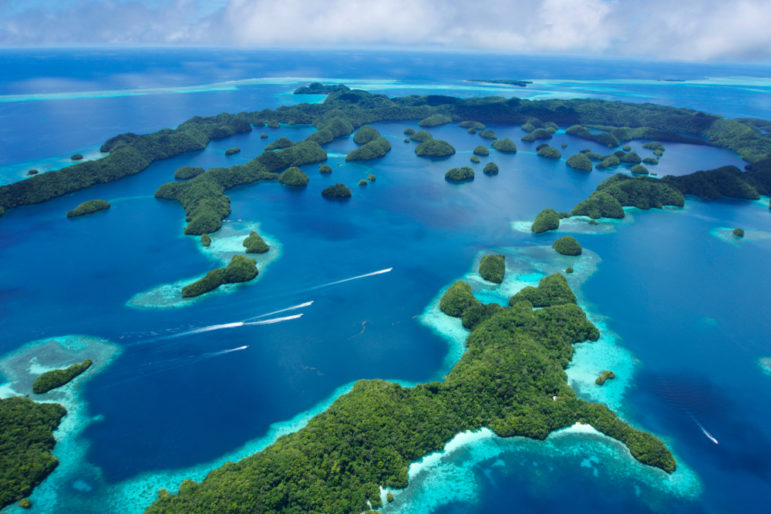
Investigative reporting in remote locations, like the South Pacific island nation of Palau, requires being resourceful about data sources and using local journalists who understand the story. Image: Shutterstock
How foreign exploitation and climate change are ravaging island nations in the South Pacific has been severely under-reported by international media.
This oversight is partly because of the access challenges of covering an oceanic region larger than Australia and partly due to Western stereotypes and apathy, according to local journalists. On the rare occasions when South Pacific stories are reported by international media, they often employ clichéd “trouble in paradise” tropes.
In response, the Guardian Australia and more than a dozen contributing Indigenous journalists — supported by The Judith Neilson Institute — have collaborated on hundreds of relevant stories in these small nations in the past two years. The stories published under the Pacific project include several investigative projects, including an epidemic of domestic violence in Papua New Guinea, a baby-selling scheme in the Marshall Islands, a shocking murder in Micronesia, and the persecution of LGBTQ people in several nations.

In a panel at the 12th Global Investigative Journalism Conference (#GIJC21), three project journalists focused on one major investigative series, “Pacific Plunder,” that explored the exploitation of natural resources in the region.
This 20-story series was built on a scaffold of data that addressed these main questions: How much timber, fish stock, and minerals are removed from Pacific nations? Where does it all go? What are the environmental costs? And what promises to Indigenous communities are being broken?
After many months spent hunting for decentralized data sources, Josh Nicholas, a data journalist at the Guardian Australia, used open source visualization tools to paint a striking picture of resource extraction: By weight, the vast majority of local resources are shipped to Japan and China, but by value, a large portion goes to Australia.
Kate Lyons, Pacific editor for the Guardian Australia, said a key component of this collaboration was integrating local reporters. “Our solution was a network of Pacific journalists, who have connections and can tell the stories of their own islands — to pay them, to train them, to get their stories out there,” said Lyons. “These reporters do brave journalism in incredibly difficult circumstances.”

Major island groups in the southern Pacific Ocean. Credit: Wikipedia
One of these reporters, Bernadette Carreon — a Palau-based freelance journalist — said project challenges included spotty internet connections, COVID-19 risks, physical safety, and travel limited by factors like wind and wave conditions.
Her investigations into fishing practices have surfaced several hidden crises in the industry, including unintended consequences of marine sanctuaries, and the unexplained and suspicious deaths of a dozen fisheries compliance officials at sea.
Carreon said the prospect of a byline in foreign or international outlets can help island reporters be more ambitious in their investigations.
“The Pacific project has raised my credibility, and kind of given me protection,” she explained. “I live in Palau, and even my Palauan colleagues have challenges, because they have this culture that you cannot shame your uncles and aunties, or your traditional chiefs, because there will be personal repercussions. So working for a bigger masthead has actually given me protection, and made me more confident.”
Tips the panel’s experts offered for investigating issues on island nations include:
- Consider the safety implications of your reporting. Lyons revealed that a potential interview for a freelance reporter with an island warlord was scrapped because security backup could not be guaranteed at its remote location. In addition, she said that — for a story about a murder on the Micronesian island of Yap — the team decided it would not be safe to ask a reporter based in Yap to investigate, simply because “the island is too small,” and assigned the story to Carreon, in Palau, instead. For contentious island stories in general, Lyons said team interviews are preferable to solo field reporting. “Something really important is to listen to the assessment of risk from the reporter,” Lyons noted.
- Collaborate with local and Indigenous reporters. “Pacific stories are sometimes reported through the lens of major countries — as a geopolitical football,” said Lyons. “Data tells part of the story, but, without Pacific reporters, we wouldn’t have gotten the human stories, the community understanding, and the amazing images.”
- Use decentralized and networked sources for data. Nicholas said up-to-date, centralized data is rare for island nations, so reporters should look for decentralized sources, and for individuals who have collected reliable data independently. “You find someone who finds someone who knows someone who’s been recording the data you need,” said Nicholas. “I came across one professor in Australia who’d been tracking the logging exports from the Solomon Islands for 30 years, and hadn’t done anything with it.”
- Pay attention to common island complaints. “Each community is unique, but we did hear the same story across different islands,” said Lyons. “A big foreign logging or mining company comes in, they reach agreements with landowners who may or may not be legitimate, and they take all of these resources where very little of the money goes to local communities, who are left with environmental harm.”
- Ask climate change questions, no matter the story subject. “This region is perhaps the first and worst affected region by climate change,” said Lyons. “Effects have occurred at two to three times the global average; some atolls are already uninhabitable. Tuvalu may not exist this century — think about that.”
Added Carreon: “The Pacific project was a great project. In terms of collaboration, it was a great model for story grants. We have amazing Pacific journalists, and, although we are separated geographically, we have rapport with each other, and I’d like to see that collaboration grow, with especially more young reporters joining.”
